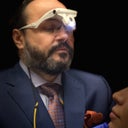Like any booming fad or fashion, there are always scammers trying to get a peice of the pie. Buttock augmentation/enhancement has become another victim - companies and individuals promoting magical creams, potions, lotions and pills...NONE OF WHICH WORK. It is not yet possible to take a substance that only and exclusively make your derrière grow. Other than being genetically blessed in the buttock and/or rigorous dedicated exercise, there is no "natural" way to grow the buttock other than surgery. Please read on for more surgical details: Regarding buttock/hip augmentation surgery, let me start off by saying that I currently see at least 2 - 3 patients, domestic and international, per week that failed "brazilian buttock lift" (i.e. the fat melted away after 10 - 12+ months) and are now seeking a more reliable and permanent option (i.e. buttock and/or hip implants). Allow me to share with you some information that you may not hear elsewhere. There are only two proven safe and relatively effective methods for Buttock Augmentation and Hip Augmentation: 1) Autologous Fat Transfer (using your own fat, transferring from one area of the body to the other) and 2) Buttock/Hip Implants (semi-solid silicone rubber implants that cannot rupture &/or leak). Both are options but what it comes down to, like any surgery, is proper patient selection and long-term results. Indeed because at least 80+ % of the fat transferred will melt away within a year, most patients are not good candidates because they lack an adequate amount of fat to harvest. Another tip is that if you purposely gain weight (i.e. fat) for the procedure, the fat you lose first as you get back to your baseline weight is that very same fat that was transferred into your buttock...so don't fall victim to this recommendation. Even those patients that had adequate amounts of fat pre-operatively, still end up seeking buttock implants after a year or so because most of the fat transferred melted away leaving them with minimal result. Although overall using your own fat is relatively safe, it not infrequently melts away unevenly leaving one butt cheek bigger than the other or with dimpling or hard fat cysts. The one serious complication that can rarely (< 1%) happen is "fat embolism" in which some of the fat gets into the blood stream and travels up into the lungs, heart, and/or brain causing serious problems. This complication is more likely to happen with the larger amount of fat being transferred. This is even more likely to happen when using fillers like liquid silicone, PMMA, Sculptra, and hyaluronic acids. Also fillers, when injected in large quantities, have a relatively high infection rate, guaranteed tendency to migrate away from the original area they were injected, and almost always stimulate a lot of inflammation with a subsequent and disastrous amount of scar tissue/hardening.Thus buttock/hip implants become a very good, safe, and long term reliable option for most patients seeking buttock/hip augmentation (at least in my practice). I prefer to insert the buttock implants through a 1 1/2 inch long incision along the inner curve of each upper buttock cheek at the level of the tailbone, similar to two opposing parentheses ")(" (concealed within the crevice between the buttock cheeks) and the hip implants through a ~ 1 inch incision just below the beltline above the hip region. The buttock implant should always be placed under or within the gluteus maximus muscle. In this position, the implant is less palpable, less visible, and does not sag or shift/migrate over time unlike implants placed on top of the muscle. On the other hand, hip implants are placed under just the fascia because no significant muscle exists in this region. However, because they are much smaller and lighter, their likelihood of migration is relatively low. Because all of this, it is extremely important to seek consultation with a board certified plastic surgeon who specializes in this procedure so that the implant placement is precise for both locations. And in this case too, at least in my surgical practice, the infection rate is minimized to






